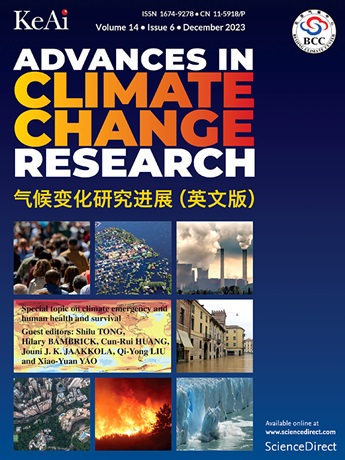北半球极端温度范围变化的探测、归因和预测
IF 5.2
1区 地球科学
Q1 ENVIRONMENTAL SCIENCES
引用次数: 0
摘要
极端温度极差(ETR)是某一年份最高温度和最低温度之间的跨度,是极端温度变异性的表现。它被认为具有重大的环境和社会影响,但人类活动对ETR变化的影响尚不清楚。基于最优指纹法,对1960-2018年北半球陆地区域ETR的变化进行了检测和归因分析。研究发现,在北半球和高纬度区域平均的时空格局中,可以检测到人为强迫并与自然强迫分离,可以检测到温室气体强迫并与人为气溶胶强迫分离。据估计,在北半球平均ETR显著下降趋势中,人为强迫(温室气体排放)贡献了129%(152%)。此外,与1999-2018年的平均值相比,在SSP5-8.5情景下,基于归因约束的预估,2081-2100年NH(北美)平均ETR将进一步显著降低6.7°C(14.0°C),其幅度大于模式原始输出。相比之下,在SSP5-8.5情景下,地中海及其邻近地区以及在SSP1-1.9情景下中欧、西非、中亚、南亚和中国部分地区的ETR预计将显著增加。这些结果对于理解和预测人类活动对极端温度变率变化的影响以及未来对这些变化的适应具有重要意义。本文章由计算机程序翻译,如有差异,请以英文原文为准。

Detection, attribution and projection of changes in the extreme temperature range in the Northern Hemisphere
The extreme temperature range (ETR) is the span between the highest and lowest temperature of a given year, and is a manifestation of extreme temperature variability. It is regarded as having significant environmental and societal impacts, but the influences of human activities on changes in the ETR remain unclear. Here we performed a detection and attribution analysis of the changes in the ETR over the land areas of the Northern Hemisphere (NH) for the period 1960–2018, based on the optimal fingerprinting approach. We found that anthropogenic forcing could be detected and separated from natural forcing, and greenhouse gas forcing could be detected and separated from anthropogenic aerosol forcing, in the spatiotemporal pattern of the NH and in the regional average of the high latitudes. It is estimated that anthropogenic forcing (greenhouse gas emissions) contributed to 129% (152%) of the significant decreasing trend in the NH-averaged ETR. Moreover, compared to the average of 1999–2018, the NH (North America)-averaged ETR was projected to further significantly decrease by 6.7 °C (14.0 °C) in 2081–2100 under the SSP5-8.5 scenario, based on attribution-constrained projection, the magnitude of which was larger than in the models’ raw outputs. In contrast, the ETR was projected to increase significantly in the Mediterranean and adjacent regions under the SSP5-8.5 scenario, and in Central Europe, West Africa, Central Asia, South Asia, and parts of China under the SSP1-1.9 scenario. These results have important implications for understanding and predicting the effects of human activities on changes in extreme temperature variability and for adaptation to these changes in the future.
求助全文
通过发布文献求助,成功后即可免费获取论文全文。
去求助
来源期刊

Advances in Climate Change Research
Earth and Planetary Sciences-Atmospheric Science
CiteScore
9.80
自引率
4.10%
发文量
424
审稿时长
107 days
期刊介绍:
Advances in Climate Change Research publishes scientific research and analyses on climate change and the interactions of climate change with society. This journal encompasses basic science and economic, social, and policy research, including studies on mitigation and adaptation to climate change.
Advances in Climate Change Research attempts to promote research in climate change and provide an impetus for the application of research achievements in numerous aspects, such as socioeconomic sustainable development, responses to the adaptation and mitigation of climate change, diplomatic negotiations of climate and environment policies, and the protection and exploitation of natural resources.
 求助内容:
求助内容: 应助结果提醒方式:
应助结果提醒方式:


